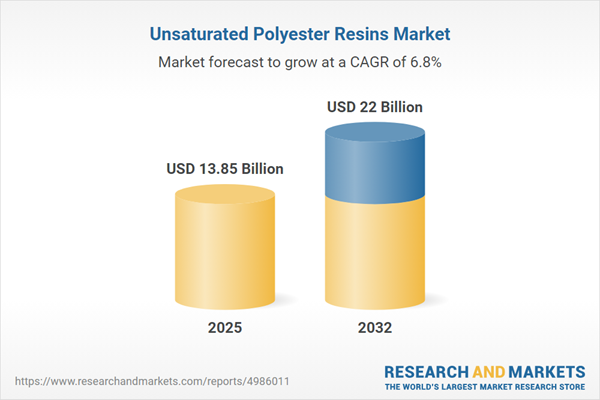Speak directly to the analyst to clarify any post sales queries you may have.
Unsaturated polyester resins play a central role in industrial evolution, enabling senior decision-makers to advance process efficiencies and meet stringent sustainability and compliance goals. These resins support organizations in adapting operations, reducing risk, and positioning for continual growth.
Market Snapshot: Unsaturated Polyester Resins Market Size and Growth Outlook
The global unsaturated polyester resins market is currently valued at USD 12.95 billion in 2024 and is projected to reach USD 22.00 billion by 2032, showcasing a solid compound annual growth rate of 6.84%. This upward trajectory is driven by improved resin technologies, more demanding regulatory frameworks, and a consistent industry focus on sustainable production methods. Core sectors such as transportation, construction, marine, electronics, and renewable energy favor unsaturated polyester resins for their adaptability, allowing organizations to respond to evolving industry needs, regulatory shifts, and emerging market opportunities. Strategic adoption of these resins enables executive leaders to strengthen operational resilience amid dynamic market conditions.
Scope & Segmentation: Strategic Opportunities in the Unsaturated Polyester Resins Market
A comprehensive review of the unsaturated polyester resins market reveals critical pathways for innovation, differentiation, and risk mitigation. Clear segment analysis equips senior leaders with actionable understanding for capitalizing on untapped industry value and maintaining competitive edge in an evolving global landscape.
- Resin Types: Orthophthalic, isophthalic, neopentyl glycol, and flame retardant options enhance durability, boost chemical resistance, and meet essential fire safety standards, supporting reliability across a spectrum of applications.
- Product Forms: Availability in liquid and powder forms ensures flexibility for producers to address tailored process requirements and scale production effectively in high-demand settings.
- Curing Processes: Advanced methods including ambient cure, bulk molding, dough molding, and sheet molding drive product consistency and align with rigorous industry performance expectations in sectors requiring meticulous standards.
- Manufacturing Processes: Techniques such as filament winding, hand lay-up, pultrusion, resin transfer molding, and spray-up provide adaptable solutions suited to diverse industrial demands and complex project specifications.
- End Use Industries: Main users in automotive, construction, electronics, marine, transportation, and wind energy sectors benefit from the dependable mechanical and chemical characteristics these resins offer, ensuring long product life and operational efficiency.
- Regional Coverage: The market spans the Americas, Europe, Middle East & Africa, and Asia Pacific, highlighting distinct regulatory environments and areas of high-growth potential, including the United States, Germany, China, and India.
- Leading Companies Analyzed: Benchmarking includes Ashland Global Holdings Inc., Allnex Belgium SA, Polynt-Reichhold S.p.A., Hexion Inc., DIC Corporation, Scott Bader Company Limited, CVC Thermoset Specialties Germany GmbH, AOC Resins B.V., Sinopec Shanghai Petrochemical Company Limited, and Arakawa Chemical Industries, Ltd., offering executives insights into shifting competitive strategies.
Key Takeaways: Actionable Insights for Senior Leadership
- Adopting unsaturated polyester resins elevates process control and supports organizational compliance as regulatory requirements evolve globally.
- Implementing advanced application and manufacturing methods enhances business flexibility, enabling rapid response to shifting customer expectations or supply chain interruptions.
- Superior chemical and corrosion resistance translates to dependable asset performance, vital for industries prioritizing operational longevity.
- Expanding and diversifying sourcing networks locally and regionally mitigates the risk of material shortages, promoting supply chain resilience.
- Sustaining responsible production and transparent sourcing not only aligns with evolving environmental and regulatory expectations but also enhances corporate reputation among stakeholders.
Tariff Impact: Navigating Evolving Trade Dynamics
Recent United States tariff adjustments underscore the strategic imperative for companies to reinforce local and regional procurement. Organizations recalibrating sourcing practices are better equipped to comply with market-specific regulatory needs, ensuring consistent materials flow for sectors like construction and marine where compliance is critical.
Methodology & Data Sources
This analysis integrates primary feedback from established manufacturers, expert interviews, and systematic evaluation of regulatory and technical documentation. The methodology ensures insights accurately reflect the latest technological developments, competitive shifts, and regulatory requirements, supporting confident strategic planning.
Why This Unsaturated Polyester Resins Market Report Matters
- In-depth segmentation clarifies the entire market structure, empowering executive leadership to make precise decisions on both product strategy and international expansion.
- Detailed regulatory and regional insights support the development of agile compliance and supply chain plans, enabling risk mitigation in rapidly changing environments.
- Competitive benchmarking supports informed partnerships and innovation, fostering operational stability even as the industry landscape evolves.
Conclusion
This report provides senior leaders with essential, actionable intelligence to drive informed choices in the unsaturated polyester resins market. Reliable analysis strengthens future-readiness and supports continued business value generation.
Additional Product Information:
- Purchase of this report includes 1 year online access with quarterly updates.
- This report can be updated on request. Please contact our Customer Experience team using the Ask a Question widget on our website.
Table of Contents
3. Executive Summary
4. Market Overview
7. Cumulative Impact of Artificial Intelligence 2025
Companies Mentioned
The companies profiled in this Unsaturated Polyester Resins market report include:- Ashland Global Holdings Inc.
- Allnex Belgium SA
- Polynt-Reichhold S.p.A.
- Hexion Inc.
- DIC Corporation
- Scott Bader Company Limited
- CVC Thermoset Specialties Germany GmbH
- AOC Resins B.V.
- Sinopec Shanghai Petrochemical Company Limited
- Arakawa Chemical Industries, Ltd.
Table Information
| Report Attribute | Details |
|---|---|
| No. of Pages | 188 |
| Published | November 2025 |
| Forecast Period | 2025 - 2032 |
| Estimated Market Value ( USD | $ 13.85 Billion |
| Forecasted Market Value ( USD | $ 22 Billion |
| Compound Annual Growth Rate | 6.8% |
| Regions Covered | Global |
| No. of Companies Mentioned | 11 |









